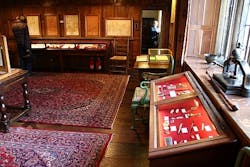The Bateman museum in Sussex Weald, UK, and home to Rudyard Kipling for 30 years, is dedicated to displaying his life and work. In the museum, the National Trust brought in lighting specialist CLD Distribution and Mike Blacker of Blacker Design to upgrade the display case lighting to LEDs. The team employed Osram’s Slimline warm white LED strips, which emit no UV rays and little heat, to preserve and best display Kipling’s books, papers, medals, and other memorabilia.
Antique case lighting
The lighting, delivered in strips of varying lengths, consumes 5W per case. This compares with the 40W per case consumed by the fiber-optic technology that preceded it. The fiber-optic solution was not only less efficient, but it was noisy, occupied significant space in the cabinets, and gave off considerable heat.
LED lighting, used in the upper and lower edges of eight cabinets, is barely visible to museum visitors.
The display cases were originally designed by Kipling’s daughter Elsie and have remained almost unchanged over the last 40 years. CLD’s Chairman Nigel Howes spoke of the need to conceal the LED strips and power supply. “The challenges of the initial design and its need to be invisible took some brain-teasing, but once we found the solution, everything was really smooth and we’re delighted with the results.” The team installed an extrusion along the front top corner of the cabinets on wooden support legs, matched to the dark wood of the cabinet. Adjustable steel brackets at each end allow for rotation, so the strips are concealed but also focusable. The power supplies are fitted underneath each cabinet.
Museum lighting
Museum lighting has long pushed the boundaries of what is possible with LED lighting -- demanding the highest color rendering index (and R9), color temperatures that best bring out the original intention of artwork, and as little heat as possible conveyed to the works.
LEDs Magazine’s Maury Wright recently had the opportunity to visit the remodeled Rijksmuseum in Amsterdam, The Netherlands. In his exclusive report, Wright discusses how light quality and minimization of damage to artwork were the most important criteria for choosing LEDs, though the energy savings were significant as well. This lighting installation, performed using Philips fixtures and Philips Lumileds LEDs, was designed to best bring out the visual characteristics of the artwork using a combination of warm-white and near-daylight color rendering throughout the museum.
Focused on works from a similar time period, an LED upgrade performed by Zumtobel in the Museo del Duomo -- the Museum of the Cathedral in Milan, Italy, highlights sculptures and paintings dating back to the 16th century.
Finally, the specific needs of museum lighting have been met with ever more impressive LED lighting designs. For instance, Lighting Projects recently introduced the ArtLED spotlight, which uses Xicato LEDs to deliver 1300 lm at a high CRI (greater than 95 Ra) for museum and art applications.





